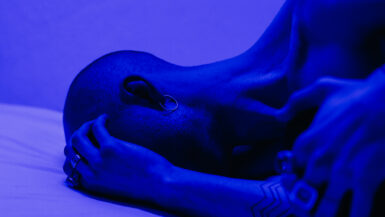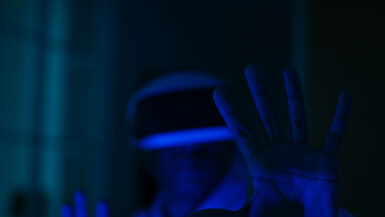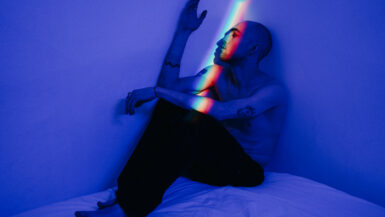In today’s technology-driven world, the pervasive presence of blue light-emitting devices has raised concerns about their influence on our well-being, particularly for teenagers who are still in critical developmental stages. This article delves into the impact of blue light on teenagers’ sleep and productivity, exploring its physiological effects on the circadian rhythm, the consequences of disrupted sleep patterns, and the potential long-term repercussions on their academic and professional performance. By examining the latest scientific research and expert opinions, we aim to provide a comprehensive understanding of this pressing issue and offer practical guidance for mitigating the negative effects of blue light exposure in our daily lives.
Effects of Blue Light Exposure on Teenagers’ Sleep Patterns
The increased use of digital devices by teenagers has led to a surge in blue light exposure, which can affect their sleep patterns in various ways. In this section, we will explore the impact of blue light on teenagers’ sleep cycles, the factors that exacerbate blue light exposure, and the potential consequences of disrupted sleep patterns.
How Blue Light Interferes with the Circadian Rhythm
Blue light, particularly from digital screens, has a profound effect on the body’s internal clock, also known as the circadian rhythm. Exposure to blue light at night can suppress the production of melatonin, a hormone that helps regulate sleep and wakefulness. As a result, teenagers may experience difficulty falling asleep, staying asleep, or feeling well-rested the next day. To gain a deeper understanding of the connection between blue light and sleep patterns, we recommend reading our article on How Blue Light Affects Sleep and Performance at Work.
Factors Contributing to Excessive Blue Light Exposure
There are several factors that contribute to the overexposure of blue light among teenagers. First, the widespread use of smartphones, tablets, and laptops exposes them to blue light for extended periods. Additionally, many teenagers use their devices in bed, which exposes them to blue light just before sleep, further disrupting their natural sleep patterns. Lastly, the use of energy-efficient LED lighting in homes and public spaces can also increase exposure to blue light.
Consequences of Disrupted Sleep Patterns
Disrupted sleep patterns can have significant implications for teenagers’ well-being, with both short-term and long-term effects. In the short term, they may experience mood swings, irritability, and difficulty concentrating during the day. Over time, chronic sleep deprivation can lead to more serious health issues, such as obesity, cardiovascular disease, and mental health problems. Moreover, poor sleep can negatively impact academic performance, as it can hinder memory retention and cognitive function.
In light of these findings, it is crucial to recognize the importance of proper sleep hygiene and take appropriate measures to reduce blue light exposure, especially during the hours leading up to bedtime. This can help teenagers maintain a healthy sleep routine and ensure they are well-rested and ready to excel in their daily activities.
Connection Between Sleep Quality and Academic Performance
The connection between sleep quality and academic performance cannot be overstated, as proper sleep is essential for optimal cognitive function, memory retention, and emotional well-being in teenagers. In this section, we will explore the various ways in which sleep quality impacts academic performance, the potential consequences of sleep deprivation on teenagers’ educational outcomes, and the role of blue light in exacerbating these issues.
The Importance of Sleep for Cognitive Function and Memory
Adequate sleep is crucial for cognitive processes such as attention, problem-solving, and critical thinking—all of which are essential for academic success. During deep sleep, the brain consolidates new information and forms long-term memories, allowing students to better retain what they have learned during the day. Additionally, proper sleep helps regulate mood and emotional well-being, which can further contribute to a positive learning environment.
Consequences of Sleep Deprivation on Educational Outcomes
Poor sleep quality can lead to detrimental effects on teenagers’ academic performance. Sleep-deprived students may struggle to concentrate in class, leading to decreased engagement and lower comprehension of new material. Furthermore, a lack of sleep can impair memory consolidation, making it more difficult for students to recall information during exams. Over time, chronic sleep deprivation can result in lower grades, increased absenteeism, and a higher risk of dropping out of school.
Role of Blue Light in Compromising Sleep Quality and Academic Performance
As previously discussed, exposure to blue light from digital devices can interfere with teenagers’ sleep patterns and circadian rhythm. When teenagers use their devices late into the night, the blue light emitted suppresses melatonin production, making it more difficult for them to fall asleep and achieve restorative sleep. Consequently, this can negatively impact their academic performance by impairing their cognitive function, memory, and emotional regulation.
Given the significant connection between sleep quality and academic performance, it is vital for parents, educators, and teenagers themselves to recognize the potential consequences of blue light exposure on sleep and take proactive steps to minimize its impact. By adopting healthy sleep habits and limiting blue light exposure, especially in the evening, teenagers can enhance their overall well-being and set themselves up for success in their academic pursuits.
Tips for Managing Screen Time and Sleep Habits
With the understanding that excessive blue light exposure can adversely impact teenagers’ sleep and productivity, it is crucial to implement strategies for managing screen time and promoting healthy sleep habits. In this section, we will provide practical tips and recommendations for reducing blue light exposure, managing screen time, and fostering a sleep-conducive environment that supports teenagers’ overall well-being and academic success.
Establishing a Digital Curfew
One effective approach for managing screen time is to establish a digital curfew, which involves setting a specific time in the evening when all electronic devices should be turned off or put away. This helps teenagers disconnect from their screens and allows their minds to unwind before bedtime. Ideally, this curfew should be set at least an hour before their intended sleep time to give their bodies ample time to adjust and prepare for rest.
Creating Screen-Free Zones and Activities
Encourage teenagers to take regular breaks from screens by designating certain areas of the home as screen-free zones, such as the dining room or bedroom. Additionally, promote engaging in screen-free activities, such as reading physical books, playing board games, or engaging in outdoor physical activities. These alternatives can help reduce blue light exposure while also fostering social interaction and physical well-being.
Utilizing Blue Light-Filtering Technology
Many digital devices now offer built-in blue light-filtering features or apps that can be downloaded to reduce the amount of blue light emitted from screens. Encourage teenagers to activate these features during evening hours or consider investing in blue light-filtering glasses for additional protection.
Improving Sleep Environment and Routine
Creating a sleep-conducive environment can significantly improve the quality of rest teenagers receive. This includes maintaining a cool, dark, and quiet bedroom, as well as investing in a comfortable mattress and pillows. Encourage teenagers to establish a consistent bedtime routine, such as taking a warm bath, reading a book, or practicing relaxation techniques like deep breathing or meditation. These rituals can signal to the body that it is time to wind down and prepare for sleep.
Educating and Encouraging Open Communication
It is essential to educate teenagers about the potential consequences of excessive blue light exposure and the importance of healthy sleep habits. Open communication and discussion can help them understand the connection between their screen time, sleep quality, and academic performance. Collaborate with them in establishing boundaries and rules around screen time, ensuring that they feel involved and empowered to make healthier choices.
By implementing these tips and promoting healthy sleep habits, teenagers can effectively manage their screen time and reduce the impact of blue light exposure on their sleep and productivity. As a result, they can enjoy improved well-being, enhanced academic performance, and a greater sense of balance in their daily lives.
Blue Light Filtering Solutions for Better Sleep
In order to mitigate the negative effects of blue light exposure on teenagers’ sleep and productivity, it is essential to explore various blue light filtering solutions that can help promote better sleep. This subsection delves into the different options available for reducing blue light exposure, from built-in device features to specialized products designed to protect the eyes and support healthy sleep patterns.
Utilizing Built-In Device Features
Many smartphones, tablets, and computers now come equipped with built-in blue light filtering features, such as Night Shift on Apple devices or Night Light on Android and Windows devices. These features can be easily activated through the device’s settings and can be scheduled to automatically turn on during evening hours. By using these built-in solutions, teenagers can reduce their exposure to blue light without needing to purchase additional products or accessories.
Installing Blue Light-Reducing Apps
In addition to built-in features, there are numerous third-party apps available for download that can help reduce blue light exposure on various devices. Examples of these apps include f.lux, Twilight, and Iris. These apps work by adjusting the color temperature of the screen, reducing the amount of blue light emitted and making it easier on the eyes during nighttime use. Encourage teenagers to explore these apps and find one that works best for them and their devices.
Investing in Blue Light-Blocking Glasses
Blue light-blocking glasses are a popular solution for individuals who spend extended periods in front of screens, especially during evening hours. These glasses are designed with special lenses that filter out a portion of blue light emitted from digital devices, reducing eye strain and potential disruption to sleep patterns. These glasses come in a variety of styles and price points, making it easy for teenagers to find a pair that suits their preferences and budget.
Choosing the Right Light Bulbs for the Home
The type of light bulbs used at home can also play a significant role in blue light exposure. Consider replacing traditional LED or fluorescent bulbs with warm-toned, low-blue light bulbs, which emit less blue light and create a more relaxing environment. Alternatively, dimmable light bulbs can be used to reduce the overall brightness and blue light exposure during the evening hours.
Establishing Screen-Free Time Before Bed
While blue light filtering solutions can help reduce the negative effects of blue light exposure, it is still essential to prioritize screen-free time before bed. Encourage teenagers to put away their devices at least an hour before bedtime and engage in calming activities such as reading, journaling, or meditating. This screen-free time can help their minds unwind and signal to their bodies that it is time for sleep.
By exploring the various blue light filtering solutions available and incorporating them into their daily routines, teenagers can effectively reduce their exposure to blue light and promote healthier sleep patterns. As a result, they can enjoy better rest and improved productivity, empowering them to excel in their academic and personal pursuits.
Understanding Blue Light and Its Sources
Before delving into the impact of blue light on teenagers’ sleep and productivity, it is crucial to first comprehend what blue light is and where it comes from. In this subsection, we will explore the nature of blue light, its sources in our daily lives, and the reasons behind its increasing prevalence in today’s technology-driven world.
Defining Blue Light and Its Place in the Light Spectrum
Blue light is a component of the visible light spectrum, which includes all the colors that can be seen by the human eye. Blue light has a wavelength of approximately 380 to 500 nanometers, making it one of the shortest and highest-energy wavelengths in the visible light spectrum. Although blue light is present in natural sunlight, its levels are balanced by other colors in the spectrum, such as red, yellow, and green, which have longer wavelengths and lower energy.
Natural Sources of Blue Light: The Sun and Its Effects on the Circadian Rhythm
The primary natural source of blue light is the sun. During daylight hours, exposure to blue light from sunlight is actually beneficial, as it helps regulate our body’s internal clock, known as the circadian rhythm. Blue light exposure during the day boosts alertness, mood, and cognitive function, preparing us for daily activities and promoting overall well-being.
Artificial Sources of Blue Light: Digital Devices and LED Lighting
In modern times, artificial sources of blue light have become increasingly prevalent due to the widespread use of digital devices such as smartphones, tablets, computers, and televisions. These screens emit significant amounts of blue light, often at close proximity to our eyes, which can lead to overexposure, particularly during evening hours when natural sunlight is no longer present. Additionally, the shift towards energy-efficient LED lighting in homes and public spaces has further contributed to the increase in blue light exposure.
The Double-Edged Sword of Blue Light in Today’s Technology-Driven World
While blue light is an essential component of our daily lives and has its benefits, it is crucial to recognize the potential risks associated with excessive exposure, especially for teenagers who are still in critical developmental stages. As we have seen, artificial sources of blue light, such as digital devices and LED lighting, have become increasingly ubiquitous and, if not managed properly, can negatively impact teenagers’ sleep and productivity. Thus, it is essential to strike a balance between the advantages and disadvantages of blue light exposure, taking into account the importance of healthy sleep habits and the role of technology in our lives.
By understanding the nature of blue light and its sources, we can better appreciate the significance of managing exposure to it, particularly for teenagers. As we continue to explore the impact of blue light on sleep and productivity, it becomes increasingly evident that fostering awareness and implementing practical strategies for managing screen time and sleep habits is essential for promoting the well-being and success of teenagers in today’s fast-paced, technology-driven world.





Leave a reply